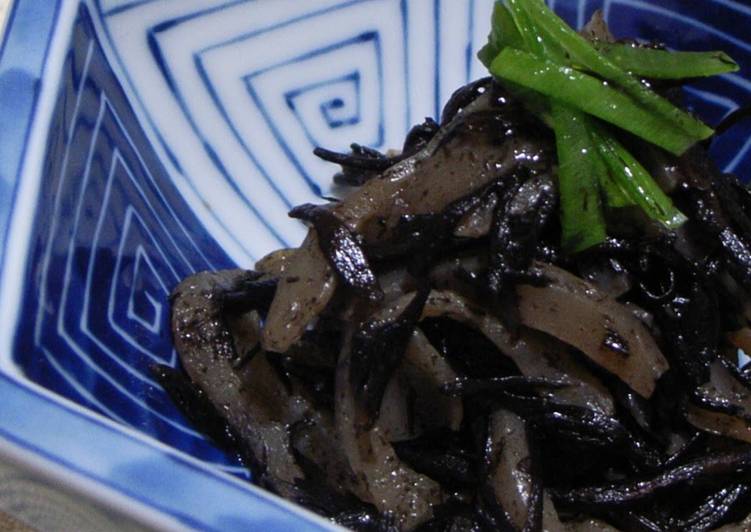
Hello everybody, hope you are having an incredible day today. Today, I will show you a way to prepare a distinctive dish, macrobiotic simmered hijiki seaweed and konnyaku. It is one of my favorites food recipes. This time, I will make it a bit unique. This is gonna smell and look delicious.
Hijiki Seaweed Salad can be made ahead of time and served as a side. It is also a popular food to include in a bento box. Because it is a simmered dish and served at room temperature, hijiki seaweed salad is usually made ahead and kept in the fridge for a few days so that it can be added to.
Macrobiotic Simmered Hijiki Seaweed and Konnyaku is one of the most favored of current trending meals on earth. It’s enjoyed by millions every day. It’s easy, it is fast, it tastes delicious. They’re fine and they look fantastic. Macrobiotic Simmered Hijiki Seaweed and Konnyaku is something which I have loved my whole life.
To begin with this particular recipe, we must prepare a few components. You can have macrobiotic simmered hijiki seaweed and konnyaku using 5 ingredients and 9 steps. Here is how you cook that.
The ingredients needed to make Macrobiotic Simmered Hijiki Seaweed and Konnyaku:
- Make ready Konnyaku
- Prepare Hijiki seaweed (dried)
- Prepare Sesame oil
- Get Soy sauce
- Make ready Green onion, parsley or other garnish
There are many kinds of seaweed commonly consumed in Japan, and all are quite low in Then there is hijiki, which may be the most versatile seaweed of all. Sea vegetables should taste of the sea, like chlorophyl with a slight iodine flavor with sea salt. This tasted flat and was somewhat mushy. Hijiki I believe is a brown seaweed so different nutrients than nori sheets.
Instructions to make Macrobiotic Simmered Hijiki Seaweed and Konnyaku:
- Parboil the konnyaku, rub it a little with salt and rinse. You can skip this step if you use konnyaku that doesn't need parboiling.
- Rinse the hijiki seaweed lightly, soak for about 5 minutes and squeeze out tightly. Don't discard the soaking water.
- Slice the konnyaku into thin rectangular slices. If the hijiki is long, cut it to the same length as the konnayku.
- Stir fry the konnyaku in a dry pan (no oil added). When the moisture on the surface is gone, push the konnyaku to the side of the pan, add the sesame oil to the empty space on the bottom, add the hijiki seaweed and stir fry to 2 to 3 minutes.
- Stir fry the konnyaku and hijiki seaweed together quickly. Add enough of the hijiki seaweed soaking water to cover the ingredients halfway (use regular water if there isn't enough soaking water).
- Bring to a boil and cover with a lid. Simmer over low heat until the hijiki seaweed is tender. If the pan gets dry before the hijiki is tender, add a little water.
- When the hijiki is tender enough to mash with your fingers, flavor with soy sauce and simmer for another 2 to 3 minutes.
- Stop simmering when there's still some liquid left in the pan. Garnish and serve.
- If you make a lot, chop some up the next day and stir-fry it with tofu to make a delicious scrambled tofu dish. You can even use it as a gyoza dumpling filling!
Konnyaku is as close to zero-calorie food you'll find—the majority of the gelatinous block is water, solidified with the addition of pulverized konnyaku powder and sometimes seaweed powder. Packages of konnayaku will range from literally zero to a whopping ten calories, depending on the brand. Typical seaweeds include Kombu seaweed, "the king of seaweed", wakame, hijiki, nori, arame, and dulse. They all are biologically different species. Kombu seaweed is specie of seaweed and the only specie that can be used for dashi broth (soup broth).
So that’s going to wrap it up for this special food macrobiotic simmered hijiki seaweed and konnyaku recipe. Thanks so much for reading. I’m confident you will make this at home. There is gonna be interesting food in home recipes coming up. Don’t forget to bookmark this page in your browser, and share it to your loved ones, colleague and friends. Thanks again for reading. Go on get cooking!


